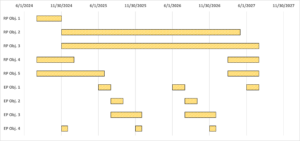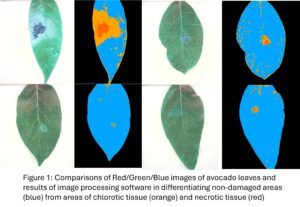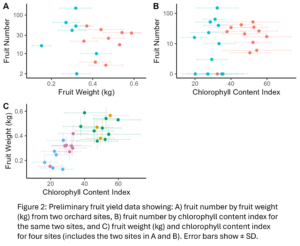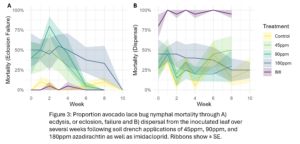Progress report for SW24-003
Project Information
Avocado lace bug (ALB), Pseudacysta perseae, is a phloem-feeding insect pest of avocado trees and is invasive to California, Florida, and Hawai’i. Feeding by ALB nymphs leads to the accumulation of large areas of necrosis on avocado leaves and eventual tree defoliation. ALB-induced leaf necrosis begins as areas of chlorotic tissue that grow larger as nymphs eclose, feed, and develop. Eventually, these necrotic areas become sufficiently large that the leaves are dropped from the tree prematurely. A sufficient number of early leaf-drop events between periods of flowering and fruit set in avocado trees has been suggested to negatively affect avocado yield, likely through decreased photosynthetic activity and reallocation of resources to new leaf growth. However, at this time it is unclear how much tree defoliation (premature leaf drop) must occur for yield effects to justify the costs of management. For avocado growers in Hawai’i, this ambiguity has led to the inefficient use of various pesticide management programs and has resulted in further economic losses, pesticide exposure to surrounding residential and natural areas, and fragility in food security for the state. Our project will investigate the association between tree defoliation and avocado yield loss from accumulated ALB damage. From these results, we will develop economic threshold models that avocado growers will be able to use as management tools for controlling ALB populations. These economic thresholds will be based on initiating management programs when certain thresholds of leaf damage across a tree are exceeded during a fruiting season. We will conduct pesticide trials using these damage thresholds and soil drenches imidacloprid to determine yield effects associated with varying degrees of ALB damage. From these findings we will be able to derive economic injury levels and develop threshold models for the imidacloprid soil drench program and several organic foliar spray programs. From this project, we will improve stakeholder and grower knowledge of how avocado lace bug (ALB) damage affects fruit yield, determine suitable economic threshold models and how they can be used in management programs for ALB, and implement these economic management thresholds in creating a more sustainable agricultural environment for Hawai’i. We will do this by (a) conducting field demonstrations on monitoring ALB damage on-farm, (b) summarizing ALB damage monitoring and economic thresholds through accessible Extension documents and scholarly articles, (c) creating accessible online video demonstrating ALB life history, damage monitoring, and economic threshold management, and (d) disseminating project results at Hawai’i grower meetings. We anticipate that results from this project will decrease economic loss for avocado growers while also reducing pesticide exposure to growers and surrounding residential/natural areas. It will also help maintain crop type diversity to aid in offsetting food insecurity in Hawai’i. The management tools developed from this project will be applicable to avocado growers in other affected areas of the USA such as California, Florida, Texas, and Puerto Rico.
Research Objectives:
- Determining an optimized subsampling method
- Conducting pesticide trials
- Examining proportion threshold effects on avocado fruit yield
- Developing an economic threshold model
- Developing economic threshold models for organic management programs
Educational Objectives:
- Conducting field demonstrations on monitoring ALB damage
- Summarizing ALB damage monitoring and economic thresholds through accessible extension documents and scholarly articles
- Creating accessible online video demonstrating ALB life history, damage monitoring, and economic threshold management
- Disseminating project results at Hawai’i grower meetings
Cooperators
- - Producer
- (Researcher)
- - Producer
- - Producer
- (Researcher)
- - Producer
- (Researcher)
Research
OBJECTIVE 1: Determine an optimized subsampling method: This research objective aims to determine the minimum number of leaves that need to be sampled from an avocado tree to be representative of the amount of avocado lace bug damage across the entire canopy. The development of the field-based imaging tools for leaves has been initiated and currently undergoing refinement with promising results. The reason for developing these tools is to be able to non-destructively access avocado lace bug damage on potentially large quantities of leaves within a canopy. From this, we can determine the optimal number of leaves to monitor during pesticide trials and determine when proportion thresholds are exceeded. It is anticipated that this objective will be completed by the Spring of 2025.
OBJECTIVE 2: Conducting pesticide trials: Soil drenches of imidacloprid will be applied to avocado trees at varying thresholds of avocado lace bug infestation based on the proportion of nymphal feeding injury across mature leaves in a canopy. These trials will consist of 12 Sharwil trees per site, with trees grouped in three experimental blocks and each block consisting of four infestation threshold treatments. Trials will be conducted at six different orchards, four on Hawai’i Island, one on O’ahu, and one on Maui. Twelve trees will be used at each orchard based on the availability of Sharwil trees orchard owners will allow us to use for this project.
OBJECTIVE 3: Examining proportion threshold effects on avocado fruit yield: This research objective will determine the association between avocado lace bug infestation/injury and potential yield loss. The number and average weight of fruit at time of harvest for each season will be collected and compared with a tree’s respective threshold treatment. In addition, the Chlorophyll Content Index (CCI) from twenty randomly selected leaves will be recorded for each tree once a month during routine monitoring. CCI can be used as a proxy for overall tree health and will help us to differentiate yield loss due to avocado lace bug injury and loss due to extraneous conditions (e.g. water stress) (1).
OBJECTIVE 4: Developing an economic threshold model: An economic threshold model will be developed through the derivation of the economic injury level (EIL) for avocado lace bug utilizing imidacloprid soil drenches. The EIL for this pesticide will require parameters including the cost of product per unit yield, the market value of avocado, the efficacy of soil drenches in preventing defoliation from avocado lace bug feeding, and yield loss per unit injury.
OBJECTIVE 5: Developing an economic threshold model for organic management programs: Economic threshold models will be developed for several other, organic pesticides and include foliar sprays of potassium salts of fatty acids, Beauveria bassiana, pyrethrum, and azadirachtin. Additionally, because azadirachtin shows systemic properties and can be taken up into leaf tissue via root application, threshold models for soil drenches of azadirachtin will also be developed (2).
We investigated the effects of azadirachtin soil drenches on the mortality of avocado lace bug nymphs to derive the efficacy of this management program to later incorporate into an EIL and threshold model. We utilized 25 potted Sharwil seedlings and applied varying concentrations of azadirachtin (45ppm, 90ppm, and 180ppm) as a soil drench along with untreated and imidacloprid soil drenches as negative and positive controls, respectively. Each treatment had five tree replicates. We then excised leaves from each of these trees at various weeks post-soil drench and inoculated the leaves with first instar avocado lace bug nymphs. The proportion of nymphs that died either through ecdysis failure (the mode of action of azadirachtin) or dispersal off the leaf were recorded for each treatment.
REFERENCES:
(1) Talebzadeh, F., & Valeo, C. (2022, April). Evaluating the effects of environmental stress on leaf chlorophyll content as an index for tree health. In IOP Conference Series: Earth and Environmental Science (Vol. 1006, No. 1, p. 012007). IOP Publishing.
(2) Acharya, R., Sharma, S. R., Barman, A. K., Kim, S. M., & Lee, K. Y. (2023). Control efficacy of azadirachtin on the fall armyworm, Spodoptera frugiperda (JE Smith) by soil drenching. Archives of Insect Biochemistry and Physiology, 113(3), e22020.
OBJECTIVE 1: Determine an optimized subsampling method: Non-destructive, field-based leaf imaging tools have been developed as well as the corresponding image processing software. The software is able to differentiate non-damaged leaf tissue from areas of chlorotic and necrotic tissue brought on by avocado lace bug nymphal feeding (Figure 1). This software will allow us to determine which leaves are currently experiencing nymphal feeding injury (i.e. presence of chlorotic tissue) or previous feeding injury (i.e. only necrotic tissue is present), which will be used to determine when proportion thresholds are exceeded.
OBJECTIVE 2: Conducting pesticide trials: Collaborations with orchard managers and extension personnel have been established across all the sites. All experimental Sharwil trees to be used for pesticide trials have been marked in corresponding blocks at each of the six sites. Soil drenches of positive control trees will begin after flowering and fruit set has concluded across all sites. Monitoring of avocado lace bug damage will also begin after flowering and fruit set.
OBJECTIVE 3: Examining proportion threshold effects on avocado fruit yield: Preliminary yield data were collected from a subset of the pesticide trial sites. These data included the number of fruit, the weights of 2-20 fruit, and the CCI of 20 leaves for each experimental tree. Results show strong variation between sites in number and average weight of fruit as well as average CCI. While there was not a strong association between fruit number and average fruit weight within trees, there did seem to be a positive association between fruit number and CCI (Figure 2A&B). There was also a strong overall association between average fruit weight and CCI, but this association differed greatly in magnitude between sites (Figure 2C).
OBJECTIVE 4: Developing an economic threshold model: We are currently compiling avocado market data from previous years to be used in developing a predictive model to forecast avocado market value at the onset of a fruiting season that will be incorporated into the EIL.
OBJECTIVE 5: Developing an economic threshold model for organic management programs: The azadirachtin soil drench study showed an increase in the proportion of nymphal mortality for azadirachtin and imidacloprid-treated trees. While nymphal mortality for imidacloprid-treated trees was mainly through dispersal off the leaf, the increase in mortality for azadirachtin-treated trees occurred through ecdysis (or eclosion) failure. The increased mortality for azadirachtin-treated trees persisted for several weeks post-soil drench, with higher concentrations showing slightly longer residual activity (Figure 3).
We have not been able to use any of the funds granted to us for this project at this time. The funds from this grant were to be used for post doc stipend/salary. However, with the current federal restrictions on hiring and establishing outgoing agreements, we may not be able to use the funds for their intended purpose for the foreseeable future. Dr. Mike Bosch, the current post doc on this project, is currently funded through a different source and has been able to pursue only some aspects of this project in the previous months. However, his current funding will run out in mid July 2025. If we are unable to access the grant funds by that time, progress on this project will slow significantly.
Research Outcomes
No recommendations can be made at this time. However, data do show azadirachtin soil drenches to have a significant effect on avocado lace bug nymphs. Future research will need to investigate whether this same pattern holds for producing avocado trees. Azadirachtin soil drenches may offer an organic, more environmentally friendly method for managing avocado lace. When implemented with our economic threshold models, it may also prove to be a more economically minded strategy.
Education and Outreach
Participation Summary:
OBJECTIVE 1: Conducting field demonstrations on monitoring ALB damage: Field demonstrations will be conducted annually and will include methods for monitoring avocado lace bug damage. These demonstrations will also include explanations of chlorotic and necrotic leaf tissue brought on by nymphal feeding as well as demonstrations of identifying the different life stages of avocado lace bug. Lastly, demonstrations will include discussions on how growers typically manage avocado lace bug and brainstorming more effective methods.
OBJECTIVE 2: Summarizing ALB damage monitoring and economic thresholds through accessible extension documents and scholarly articles: Extension bulletins will be published through the University of Hawai’i at Manoa. These will be comprised of avocado lace bug monitoring methods as well as information on economic thresholds and the association avocado lace bug damage and yield loss. Scholarly papers will also be published based on our findings from the pesticide trials and economic threshold model development.
OBJECTIVE 3: Creating accessible online video demonstrating ALB life history, damage monitoring, and economic threshold management: Online videos will be creating showing different aspects of avocado lace bug life history, feeding injury, and applications of economic thresholds for management strategies. These videos will also include demonstrations of methods for monitoring avocado lace bug injury.
OBJECTIVE 4: Disseminating project results at Hawai’i grower meetings: We will speak at annual grower meetings across Hawai’i and will present our findings on the association between yield loss and avocado lace bug injury. We will also present on the concepts of economic injury levels and threshold models. These presentations will be followed by discussion and Q&A sessions with growers and stakeholders.
OBJECTIVE 1: Conducting field demonstrations on monitoring ALB damage: There are no results for this education objective at this time. However, we are still on schedule to beginning field demonstrations starting the Summer of 2025.
OBJECTIVE 2: Summarizing ALB damage monitoring and economic thresholds through accessible extension documents and scholarly articles: We are currently preparing a short communications manuscript on the effects of azadirachtin soil drenches on avocado lace bug nymphal mortality to be published in the Journal of Economic Entomology.
OBJECTIVE 3: Creating accessible online video demonstrating ALB life history, damage monitoring, and economic threshold management: There are no results for this education objective currently. However, we are still on schedule for beginning video development in the Fall of 2025.
OBJECTIVE 4: Disseminating project results at Hawai’i grower meetings: There are no results for this education objective at this time. However, we have been invited to present this work at an avocado lace bug management and control workshop scheduled on February 26th 2025. The workshop is hosted by the University of Hawai’i College of Tropical Agriculture and Human Resilience Kona Research and Extension Center. We have also been invited to present our economic threshold project at the Hawai’i Tropical Fruit Growers meeting in October 2025. Additionally, our work on azadirachtin soil drenching has been presented at the Global Agriculture Multidisciplinary International Conference to fellow agricultural researchers in November 2024.
Education and Outreach Outcomes
There are no recommendations that can be made at this time.
- Not applicable at this time in the project.
Not applicable at this time in the project.



